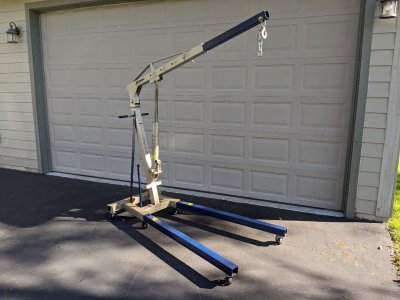I have a nice robust engine hoist that I use around the shop frequently as a general purpose shop crane (no engine work). It's built from thick wall square tubing, and consequently heavy. It is quite stout, 2-ton capacity, and made by AC Delco. The only thing I don't like about it is that the legs don't fold up. I have to lift them vertically out of their "keepers", then slide them into place horizontally, and pin them. Getting the angle right is compounded by the fact that the legs are so heavy (and getting heavier every year). It's a man and wife effort to get the angle correct to slide the legs into place.
I'd prefer folding legs, but the affordable HF 2-ton engine hoist is thinner wall tubing and probably has less capacity even though it claims the same capacity.
I'm surprised that I cannot find any examples on the web of someone modifying a hoist like mine to make the legs fold. It would entail removing the top surface of the square tubing of the base and drilling some new holes for folding and pinning, and possibly removing the old vertical "keepers" for the legs.
I'm reluctant to tear into this mod for fear I might compromise a perfectly good hoist.
Has anyone on the forum preformed such a mod, and how successful was it?
I'd prefer folding legs, but the affordable HF 2-ton engine hoist is thinner wall tubing and probably has less capacity even though it claims the same capacity.
I'm surprised that I cannot find any examples on the web of someone modifying a hoist like mine to make the legs fold. It would entail removing the top surface of the square tubing of the base and drilling some new holes for folding and pinning, and possibly removing the old vertical "keepers" for the legs.
I'm reluctant to tear into this mod for fear I might compromise a perfectly good hoist.
Has anyone on the forum preformed such a mod, and how successful was it?


